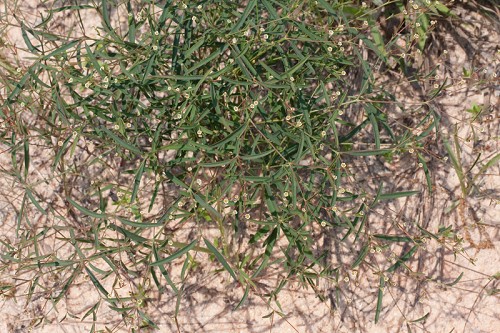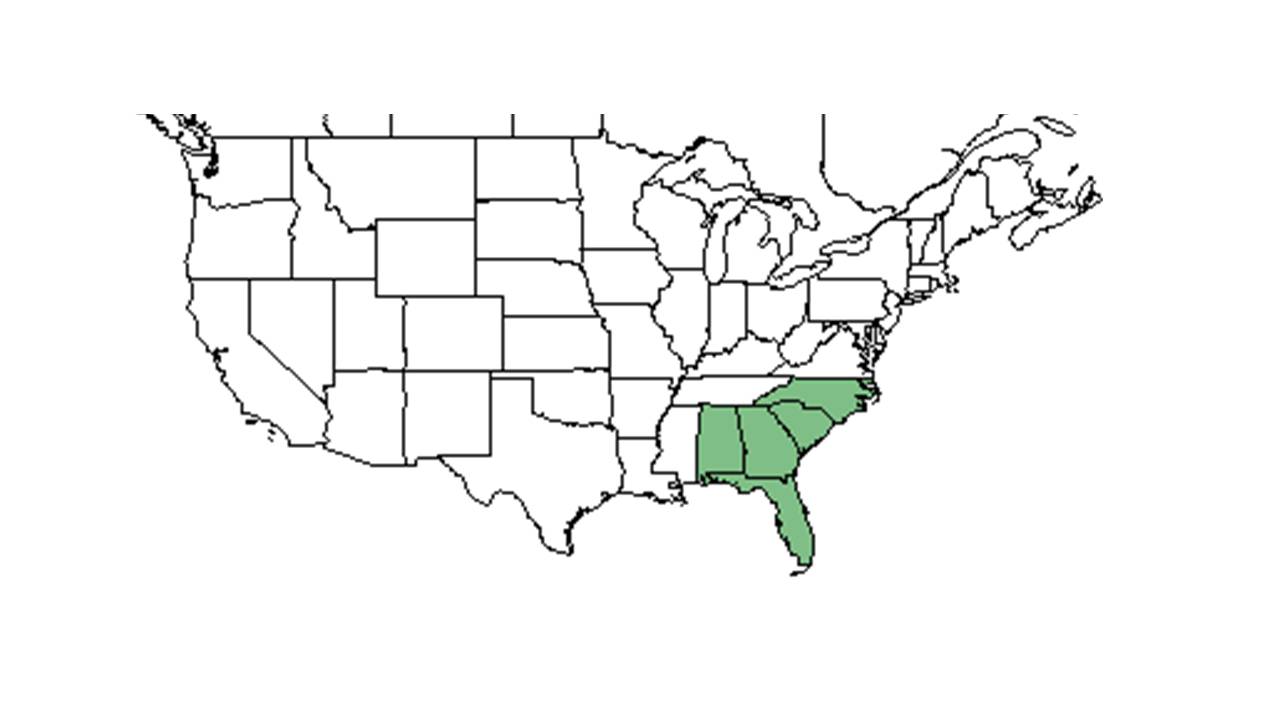Difference between revisions of "Euphorbia curtisii"
(→Taxonomic notes) |
Krobertson (talk | contribs) (→Ecology) |
||
| (One intermediate revision by one other user not shown) | |||
| Line 31: | Line 31: | ||
==Distribution== | ==Distribution== | ||
==Ecology== | ==Ecology== | ||
| − | + | ||
===Habitat=== <!--Natural communities, human disturbed habitats, topography, hydrology, soils, light, fire regime requirements for removal of competition, etc.--> | ===Habitat=== <!--Natural communities, human disturbed habitats, topography, hydrology, soils, light, fire regime requirements for removal of competition, etc.--> | ||
''E. curtisii'' occurs in wet pine flatwoods, in longleaf pinelands and savannas. It has been spotted in human disturbed areas such as along roadsides and in edges of flatwoods. It may also be associated with areas that have been disturbed where the soil is a heavy sticky clay type.<ref name=fsu>Florida State University Robert K. Godfrey Herbarium database. URL: http://herbarium.bio.fsu.edu. Last accessed: June 2014. Collectors: Robert K. Godfrey and Roy Komarek. States and Counties: Florida: Jefferson, Leon, and Wakulla. Georgia:Thomas.</ref> | ''E. curtisii'' occurs in wet pine flatwoods, in longleaf pinelands and savannas. It has been spotted in human disturbed areas such as along roadsides and in edges of flatwoods. It may also be associated with areas that have been disturbed where the soil is a heavy sticky clay type.<ref name=fsu>Florida State University Robert K. Godfrey Herbarium database. URL: http://herbarium.bio.fsu.edu. Last accessed: June 2014. Collectors: Robert K. Godfrey and Roy Komarek. States and Counties: Florida: Jefferson, Leon, and Wakulla. Georgia:Thomas.</ref> | ||
| − | ''E. curtisii'' was found to become absent or decrease in occurrence in response to soil disturbance by agriculture in southwest Georgia. It has shown resistance to regrowth in reestablished pineland habitat that was disturbed by these practices.<ref name=ostertag> Ostertag, T. E. and K. M. Robertson. 2007. A comparison of native versus old-field vegetation in upland pinelands managed with frequent fire, South Georgia, USA. Tall Timbers Fire Ecology Conference Proceedings 23: 109-120.</ref> | + | ''E. curtisii'' was found to become absent or decrease in occurrence in response to soil disturbance by agriculture in southwest Georgia. It has shown resistance to regrowth in reestablished pineland habitat that was disturbed by these practices.<ref name=ostertag> Ostertag, T. E. and K. M. Robertson. 2007. A comparison of native versus old-field vegetation in upland pinelands managed with frequent fire, South Georgia, USA. Tall Timbers Fire Ecology Conference Proceedings 23: 109-120.</ref> Additionally, the plant was found to be a decreaser in its long-term response following cessation of repeated soil disturbance.<ref name=Dixon>Dixon, C. M., K. M. Robertson, A. M. Reid and M. T. Rother. 2024. Mechanical soil disturbance in a pine savanna has multiyear effects on plant species composition. Ecosphere 15(2):e4759.</ref> |
Associated species include wiregrass, ''Quercus pumila, Q. minima, Serenoa repens.''<ref name=fsu/> | Associated species include wiregrass, ''Quercus pumila, Q. minima, Serenoa repens.''<ref name=fsu/> | ||
| Line 41: | Line 41: | ||
''Euphorbia curtisii'' is an indicator species for the Panhandle Silty Longleaf Woodlands community type as described in Carr et al. (2010).<ref>Carr, S.C., K.M. Robertson, and R.K. Peet. 2010. A vegetation classification of fire-dependent pinelands of Florida. Castanea 75:153-189.</ref> | ''Euphorbia curtisii'' is an indicator species for the Panhandle Silty Longleaf Woodlands community type as described in Carr et al. (2010).<ref>Carr, S.C., K.M. Robertson, and R.K. Peet. 2010. A vegetation classification of fire-dependent pinelands of Florida. Castanea 75:153-189.</ref> | ||
| + | ''E. curtisii'' was absent before herbicide treatments near the end of the growing season but present after. This might be because of increased availability of resources.<ref>Bohn, K. K., P. Minogue, et al. (2011). "Control of invasive Japanese Climbing Fern (Lygodium japonicum) and response of native ground cover during restoration of a disturbed longleaf pine ecosystem." Ecological Restoration 29: 346-356.</ref> | ||
===Phenology=== <!--Timing off flowering, fruiting, seed dispersal, and environmental triggers. Cite PanFlora website if appropriate: http://www.gilnelson.com/PanFlora/ --> | ===Phenology=== <!--Timing off flowering, fruiting, seed dispersal, and environmental triggers. Cite PanFlora website if appropriate: http://www.gilnelson.com/PanFlora/ --> | ||
''E. curtisii'' has been observed flowering in April and May.<ref>Nelson, G. [http://www.gilnelson.com/ PanFlora]: Plant data for the eastern United States with emphasis on the Southeastern Coastal Plains, Florida, and the Florida Panhandle. www.gilnelson.com/PanFlora/ Accessed: 9 DEC 2016</ref> | ''E. curtisii'' has been observed flowering in April and May.<ref>Nelson, G. [http://www.gilnelson.com/ PanFlora]: Plant data for the eastern United States with emphasis on the Southeastern Coastal Plains, Florida, and the Florida Panhandle. www.gilnelson.com/PanFlora/ Accessed: 9 DEC 2016</ref> | ||
Latest revision as of 15:51, 11 November 2024
| Euphorbia curtisii | |
|---|---|

| |
| Photo by John R. Gwaltney, Southeastern Flora.com | |
| Scientific classification | |
| Kingdom: | Plantae |
| Division: | Magnoliophyta - Flowering plants |
| Class: | Magnoliopsida – Dicotyledons |
| Order: | Euphorbiales |
| Family: | Euphorbiaceae |
| Genus: | Euphorbia |
| Species: | E. curtisii |
| Binomial name | |
| Euphorbia curtisii Engelm. | |

| |
| Natural range of Euphorbia curtisii from USDA NRCS Plants Database. | |
Common name: Curtis' spurge, white sandhills spurge
Contents
Taxonomic notes
Synonyms: none[1]
Varieties: Tithymalopsis curtisii (Engelmann) Small; Tithymalopsis eriogonoides Small[1]
Description
Generally, for the Euphorbia genus, they are "large and variable genus of annual and perennial, lactiferous, herbs, trees, and shrubs. Leaves opposite, alternate or some in a combination including whorled, entire, crenate, serrate or lobed. Flowers unisexual, borne in cyathia (involucres resembling flowers) with 4 or 5 lobes, at least one bearing a large gland, often with petaloid appendages. Each cyathium usually contains one pistillate flower and 2-15 or more staminate flowers; the staminate flower consists of a single stamen; the pistillate of a single pistil with 3-locules. Capsule 3-locular, each locule 1- seeded." [2]
Specifically, for Euphorbia curtisii species, they are "similar to E. ipecacuanhae. Stems stiffly erect, freely branched; lowers branches alternate, the upper ones opposite. Lower leaves mostly bract-like, alternate, the upper opposite, linear, lanceolate or oblong, glabrous or pubescent, 1-6 cm long, 0.5-1.5 mm wide, petioles 0.5-5 mm long. Peduncles 0.3-2 cm long. Cyathia glabrous or pubescent, 1.5-3 mm broad, petaloid appendages of glands white or pale pink, 0.8-1.3 mm long; 1-1.5 mm wide. Capsules remotely pubescent or glabrous, 2.5-3 mm long; pedicels exserted less than 1 mm from cyathia. Seeds gray mottled with reddish brown, 1.8-2 mm long." [2]
Distribution
Ecology
Habitat
E. curtisii occurs in wet pine flatwoods, in longleaf pinelands and savannas. It has been spotted in human disturbed areas such as along roadsides and in edges of flatwoods. It may also be associated with areas that have been disturbed where the soil is a heavy sticky clay type.[3]
E. curtisii was found to become absent or decrease in occurrence in response to soil disturbance by agriculture in southwest Georgia. It has shown resistance to regrowth in reestablished pineland habitat that was disturbed by these practices.[4] Additionally, the plant was found to be a decreaser in its long-term response following cessation of repeated soil disturbance.[5]
Associated species include wiregrass, Quercus pumila, Q. minima, Serenoa repens.[3]
Euphorbia curtisii is an indicator species for the Panhandle Silty Longleaf Woodlands community type as described in Carr et al. (2010).[6]
E. curtisii was absent before herbicide treatments near the end of the growing season but present after. This might be because of increased availability of resources.[7]
Phenology
E. curtisii has been observed flowering in April and May.[8]
Fire ecology
This species has been seen in longleaf pinelands after a prescribed burn.[3]
Conservation, cultivation, and restoration
E. curtisii should avoid soil disturbance by agriculture to conserve its presence in pine communities.[4]
Cultural use
Members of this genus can be used as a laxative in small amounts, but an overdose can cause severe poisoning.[9]
Photo Gallery
References and notes
- ↑ 1.0 1.1 Weakley, A.S. 2020. Flora of the Southeastern United States. Edition of 20 October 2020. University of North Carolina at Chapel Hill, Chapel Hill, North Carolina.
- ↑ 2.0 2.1 Radford, Albert E., Harry E. Ahles, and C. Ritchie Bell. Manual of the Vascular Flora of the Carolinas. 1964, 1968. The University of North Carolina Press. 668-672. Print.
- ↑ 3.0 3.1 3.2 Florida State University Robert K. Godfrey Herbarium database. URL: http://herbarium.bio.fsu.edu. Last accessed: June 2014. Collectors: Robert K. Godfrey and Roy Komarek. States and Counties: Florida: Jefferson, Leon, and Wakulla. Georgia:Thomas.
- ↑ 4.0 4.1 Ostertag, T. E. and K. M. Robertson. 2007. A comparison of native versus old-field vegetation in upland pinelands managed with frequent fire, South Georgia, USA. Tall Timbers Fire Ecology Conference Proceedings 23: 109-120.
- ↑ Dixon, C. M., K. M. Robertson, A. M. Reid and M. T. Rother. 2024. Mechanical soil disturbance in a pine savanna has multiyear effects on plant species composition. Ecosphere 15(2):e4759.
- ↑ Carr, S.C., K.M. Robertson, and R.K. Peet. 2010. A vegetation classification of fire-dependent pinelands of Florida. Castanea 75:153-189.
- ↑ Bohn, K. K., P. Minogue, et al. (2011). "Control of invasive Japanese Climbing Fern (Lygodium japonicum) and response of native ground cover during restoration of a disturbed longleaf pine ecosystem." Ecological Restoration 29: 346-356.
- ↑ Nelson, G. PanFlora: Plant data for the eastern United States with emphasis on the Southeastern Coastal Plains, Florida, and the Florida Panhandle. www.gilnelson.com/PanFlora/ Accessed: 9 DEC 2016
- ↑ Mueschner, W.C. 1957. Poisonous Plants of the United States. The Macmillan Company, New York.